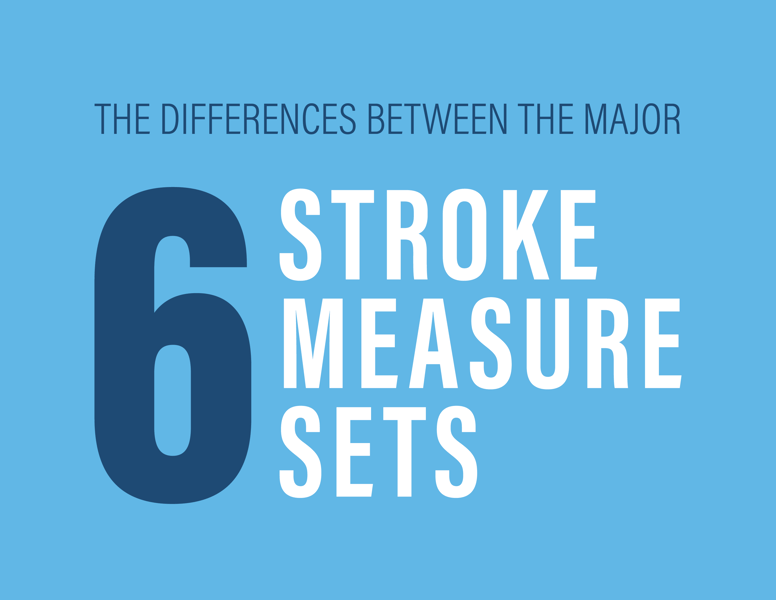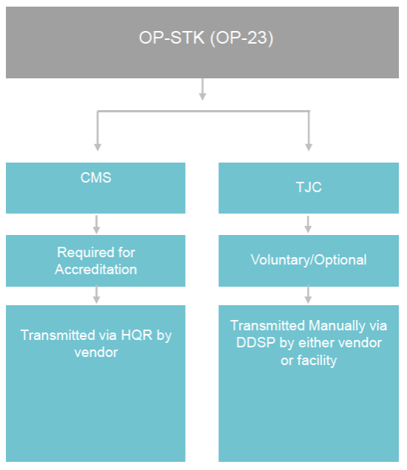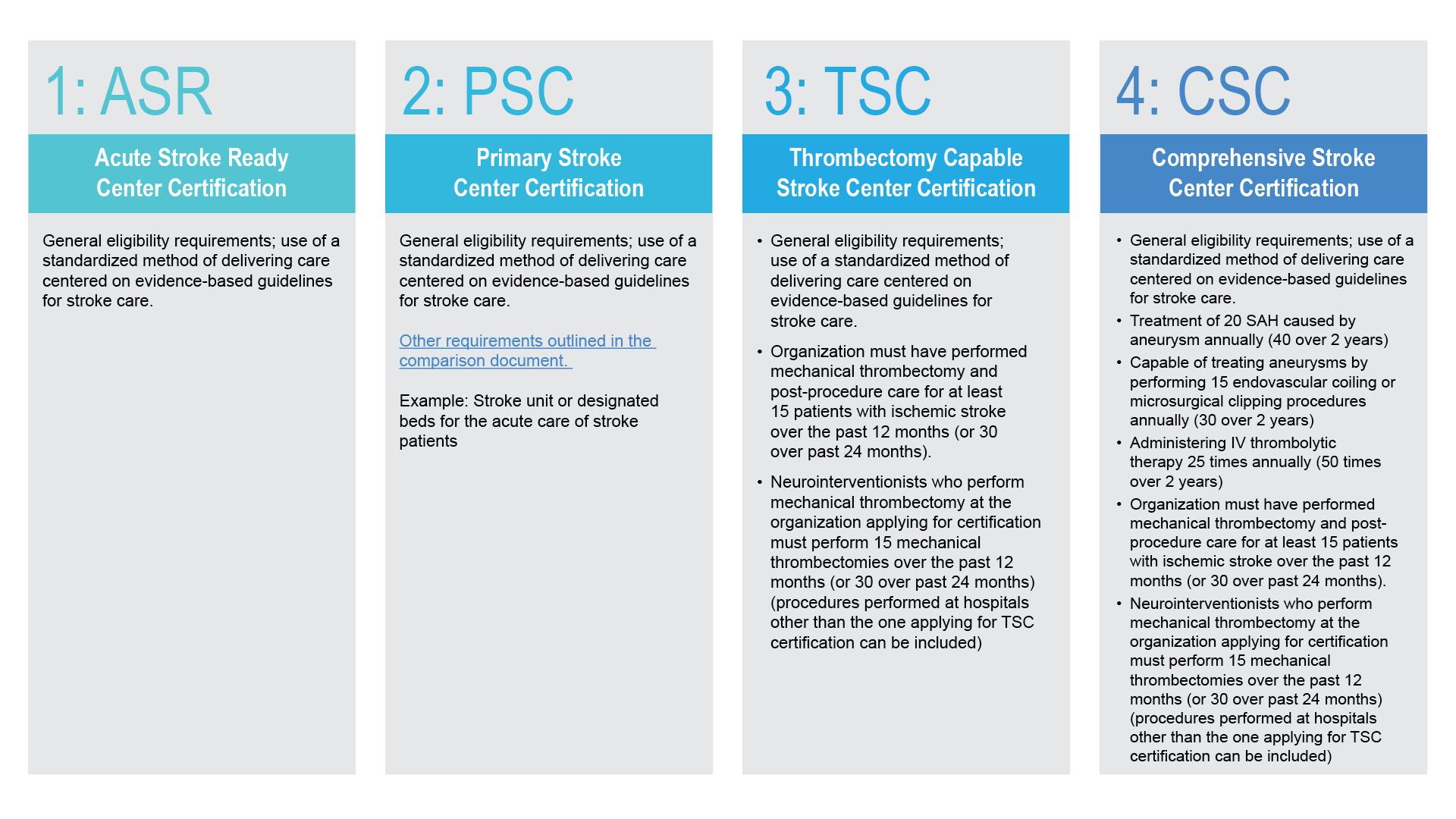The Differences Between The 6 Major Stroke Measure Sets

This post is a guide to understanding the differences between the six major stroke measure sets. It’s a nightmare trying to keep straight this wide range of acronym-filled information. So, I’ve attempted to structure it in a way that will be a reference for you.
Here’s how this post is organized.
Part 1: A review of the different stroke measure sets
This section includes the measure type (inpatient vs outpatient), the number of measures in the set, which certification the measure set is a part of, a list of the measures in the set and the associated algorithm.
Part 2: A review of the different stroke certifications
This section reviews The Joint Commission certifications and clarifies the CMS accreditation requirement. I also included the complete list of measures required for each certification.
Part 3: How to report stroke information
In the last section, I review the way this information is submitted to The Joint Commission and CMS.
Oh, also, I included a ton of resources and links throughout this article and a specific list of resources at the end.
Part 1: A review of the different stroke measure sets
There are six major stroke measure sets. You’ll see them abbreviated like this:
- CSTK
- STK
- ASR IP/OP
- STK OP
- OP STK
- OP STK
Measure Set #1
CSTK: Comprehensive Stroke or C-Stroke
Measure Type: Inpatient
Number of Measures Included: 11
Certification Requirement: The Joint Commission’s Comprehensive Stroke Certification
*Note: There are additional measures needed to fulfill this certification. Program details are found in Part 2.
Measures:
Links to measure specifications
| Set Measure ID | Measure Short Name |
| CSTK-01 | National Institutes of Health Stroke Scale (NIHSS Score Performed for Ischemic Stroke Patients) |
| CSTK-02 | Modified Rankin Score (mRS at 90 Days) **SUSPENDED for Thrombectomy-Capable Stroke Centers, Effective July 1, 2022** |
| CSTK-03 |
Severity Measurement Performed for SAH and ICH Patients (Overall Rate) |
| CSTK-04 | Procoagulant Reversal Agent Initiation for Intracerebral Hemorrhage (ICH ) |
| CSTK-05 | Hemorrhagic Transformation (Overall Rate) |
| CSTK-06 | Nimodipine Treatment Administered |
| CSTK-08 | Thrombolysis in Cerebral Infarction (TICI Post-Treatment Reperfusion Grade) |
| CSTK-09 | Arrival Time to Skin Puncture (Overall Rate) |
| CSTK-10 | Modified Rankin Score (mRS at 90 Days: Favorable Outcome) |
| CSTK-11 | Rate of Rapid Effective Reperfusion From Hospital Arrival |
| CSTK-12 |
Rate of Rapid Effective Reperfusion From Skin Puncture |
Algorithm:

Once a patient is qualified, he/she moves to the second part of the algorithm which tells you which sub-population he/she falls into.
- Sub-Population 1: Ischemic Stroke
- Sub-Population 2: Ischemic Stroke with IV t-PA, IA, t-PA, or MER
- Sub-Population 3: Hemorrhagic Stroke
Algorithm:

Measure Set #2
STK: Stroke
Measure Type: Inpatient
Number of Measures Included: 8
Certification Requirement: The Joint Commission’s Primary Stroke Certification
Measures:
| Set Measure ID | Measure Short Name |
| STK-1 |
Venous Thromboembolism (VTE Prophylaxis) |
| STK-2 |
Discharged on Antithrombotic Therapy |
| STK-3 |
Anticoagulation Therapy for Atrial Fibrillation/Flutter |
| STK-4 | Thrombolytic Therapy |
| STK-5 |
Antithrombotic Therapy By End of Hospital Day Two |
| STK-6 | Discharged on Statin Medication |
| STK-8 |
Stroke Education |
| STK-10 | Assessed for Rehabilitation |
Algorithm:

Much like we saw how cases fall into their respective sub-populations with CSTK, cases for STK use the same criteria when determining which sub-population a case will qualify for. If the Principal Diagnosis code falls on Table 8.1 it will be placed in the Ischemic Stroke, or sub-pop 1 and if it has a Principal Diagnosis code that falls on Table 8.2, then it will be placed in the Hemorrhagic Stroke or sub-pop-2.
The next measure set we review is abbreviated ASR-IP/OP. Here I have broken it into the inpatient measure set and the outpatient measure set.
Measure Set #3-1
ASR-IP: Acute Stroke Ready – Inpatient
Measure Type: Inpatient
Number of Measures Included: 3 process measures
Certification Requirement: The Joint Commission’s Disease-Specific Care Certification
Measures:
| Set Measure ID | Measure Short Name |
| ASR-IP-1 | Thrombolytic Therapy: Inpatient Admission |
| ASR-IP-2 | Antithrombotic Therapy By End of Hospital Day 2 |
| ASR-IP-3 |
Discharged on Antithrombotic Therapy |
Algorithm:

Measure Set #3-2
ASR-OP: Acute Stroke Ready – Outpatient
Measure Type: Outpatient
Number of Measures Included: 2 process measures
Certification Requirement: The Joint Commission’s Disease-Specific Care Certification
Measures:
| Set Measure ID | Measure Short Name |
| ASR-OP-1 | Thrombolytic Therapy: Drip and Ship |
Algorithm:

Measure Set #4
STK-VOL-1: Stroke Volume
*Note: New Measure began July 1, 2022. It measures Ischemic Stroke Patients Who Receive Mechanical Endovascular Reperfusion Therapy. Only Primary Stroke Centers (PSC) who perform this procedure within their facility are required to report this simple count of the number of MT procedures performed at the PSC each month.
Measure Type: Inpatient
Number of Measures Included: 1 process measure
Certification Requirement: The Joint Commission’s Primary Stroke Certification
Measures:
|
Set Measure ID |
Measure Short Name |
|
Stroke Volume |
Algorithm:

Measure Set #5
STK-OP: Stroke Outpatient
*Note: Significant changes to this measure set began July 1, 2021.
Measure Type: Outpatient
Number of Measures Included: There are seven process measures (you’ll see one additional measure listed below that is not reported and one additional measure that is retired starting with July 1, 2021, discharges). TJC is added three additional measures beginning with July 1, 2021, discharges.
Certification Requirement: The Joint Commission’s Primary Stroke Certification
Measures:
| Set Measure ID | Measure Short Name |
| STK-OP-1 | Door to Transfer to Another Hospital |
| STK-OP-1a |
Overall Rate (Not Reported) |
| STK-OP-1b |
Hemorrhagic Stroke |
| STK-OP-1c |
Ischemic Stroke; IV Alteplase Prior to Transfer (Drip and Ship) |
| STK-OP-1d |
Ischemic Stroke; No IV Alteplase Prior to Transfer, LVO and MER Eligible |
| STK-OP-1e |
Ischemic Stroke; No IV Alteplase Prior to Transfer, LVO and NOT MER Eligible |
| STK-OP-1f |
Ischemic Stroke; No IV Alteplase Prior to Transfer, No LVO |
| STK-OP-1g |
Ischemic Stroke; IV Alteplase Prior to Transfer, LVO and MER Eligible |
| STK-OP-1h |
Ischemic Stroke; IV Alteplase Prior to Transfer, LVO and NOT MER Eligible |
| STK-OP-1i |
Ischemic Stroke; IV Alteplase Prior to Transfer, No LVO |
Algorithm:

Measure Set #6
OP-STK: Outpatient Stroke
Measure Type: Outpatient
Number of Measures Included: 1 process measure
Accreditation Requirement: CMS Outpatient Quality Reporting program
Measures:
| Set Measure ID | Measure Short Name |
| OP-23 | Head CT or MRI Scan Results for Acute Ischemic Stroke or Hemorrhagic Stroke Patients who Received Head CT or MRI Scan Interpretation Within 45 minutes of ED Arrival |
Algorithm:

Honestly though – Stroke Outpatient versus Outpatient Stroke. What is wrong with these people making it so complicated for us?
Here’s a good reference document in case you get confused. You can download it or email it to yourself to help you remember.
Part 2: A review of the different certifications
To begin, I will clarify the two Measure Stewards we are reviewing today (there are many other Measure Stewards out there). The Measure Steward refers to the organization that is responsible for providing the required measure information for the measure maintenance process that occurs approximately every three years. They are responsible for making the necessary updates to the measure and for informing NQF (National Quality Forum) about any changes that are made to the measure on an annual basis.
In this post we are either referencing CMS or The Joint Commission as the Measure Stewards.
The following links provide you with information available on past, present and future versions of the specification manuals, including release notes, measure information forms, data dictionaries, missing and invalid data, population and sampling, data transmission, tools and resources, and appendices.
Regarding stroke, The Joint Commission has four different types of certification programs that go along with these stroke measure sets. Each certification may require your hospital to submit one or more of the five measure sets we reviewed above. They also could require other measures.
The four TJC stroke certification programs
Here’s a link to TJC’s full program comparison sheet with guidelines of certification requirements.
The following are the list of required chart-abstracted stroke measures for each certification program.
ASR Acute Stroke Ready Center Certification
Measures for TJC Acute Stroke Ready Center Certification
1. ASR-IP-1: Thrombolytic Therapy (IV alteplase initiated in the ED followed by inpatient admission to the ASRH)
2. ASR-IP-2: Antithrombotic Therapy Administered By End of Hospital Day 2
3. ASR-IP-3: Discharged on Antithrombotic Therapy
4. ASR-OP-1 Thrombolytic Therapy (Drip and Ship)
5. ASR OP-2 Door to Transfer to Another Hospital
1. STK-OP-1a Overall Rate (Not Reported)
2. STK-OP-1b Hemorrhagic Stroke
3. STK-OP-1c Ischemic Stroke; IV Alteplase Prior to Transfer (Drip and Ship) **RETIRED 7/1/2021**
4. STK-OP-1d Ischemic Stroke; No IV Alteplase Prior to Transfer, LVO and MER Eligible
5. STK-OP-1e Ischemic Stroke; No IV Alteplase Prior to Transfer, LVO and NOT MER Eligible
6. STK-OP-1f Ischemic Stroke; No IV Alteplase Prior to Transfer, No LVO
7. STK-OP-1g Ischemic Stroke; IV Alteplase Prior to Transfer, LVO and MER Eligible
**ADDED as of 7/1/2021**
8. STK-OP-1h Ischemic Stroke; IV Alteplase Prior to Transfer, LVO and NOT MER Eligible
**ADDED as of 7/1/2021**
9. STK-OP-1i Ischemic Stroke; IV Alteplase Prior to Transfer, No LVO
**ADDED as of 7/1/2021**
PSC Primary Stroke Center Certification
Measures for TJC Primary Stroke Center Certification
1. CSTK-01 National Institutes of Health Stroke Scale (NIHSS Score Performed for Ischemic Stroke Patients)
2. STK-OP-1 Door to Transfer to Another Hospital
1. STK-OP-1a Overall Rate (Not Reported
2. STK-OP-1b Hemorrhagic Stroke
3. STK-OP-1c Ischemic Stroke; IV Alteplase Prior to Transfer (Drip and Ship) **RETIRED 7/1/2021**
4. STK-OP-1d Ischemic Stroke; No IV Alteplase Prior to Transfer, LVO and MER Eligible
5. STK-OP-1e Ischemic Stroke; No IV Alteplase Prior to Transfer, LVO and NOT MER Eligible
6. STK-OP-1f Ischemic Stroke; No IV Alteplase Prior to Transfer, No LVO
7. STK-OP-1g Ischemic Stroke; IV Alteplase Prior to Transfer, LVO and MER Eligible
**ADDED as of 7/1/2021**
8. STK-OP-1h Ischemic Stroke; IV Alteplase Prior to Transfer, LVO and NOT MER Eligible
**ADDED as of 7/1/2021**
9. STK-OP-1i Ischemic Stroke; IV Alteplase Prior to Transfer, No LVO
**ADDED as of 7/1/2021**
3. STK-1 Venous Thromboembolism (VTE Prophylaxis)
4. STK-2 Discharged on Antithrombotic Therapy
5. STK-3 Anticoagulation Therapy for Atrial Fibrillation/Flutter
6. STK-4 Thrombolytic Therapy
7. STK-5 Antithrombotic Therapy By End of Hospital Day Two
8. STK-6 Discharged on Statin Medication
9. STK-8 Stroke Education
10. STK-10 Assessed for Rehabilitation
11. STK-VOL-1 Ischemic Stroke Patients Who Receive Mechanical Endovascular Reperfusion Therapy
*Additional Measures for Primary Stroke Centers Performing Mechanical Thrombectomy Procedures
- CSTK-02Modified Rankin Score (mRS at 90 Days)
- CSTK-05Hemorrhagic Transformation (Overall Rate)
1. CSTK-05a: Hemorrhagic Transformation for Patients Treated with Intra-venous (IV) Alteplase Therapy Only
2. CSTK-05b: Hemorrhagic Transformation Patients Treated with Intra-Arterial (IA) Alteplase Therapy or Mechanical Endovascular Reperfusion Therapy - CSTK-08Thrombolysis in Cerebral Infarction (TICI Post-Treatment Reperfusion Grade)
- CSTK-09Arrival Time to Skin Puncture (Overall Rate)
1. CSTK-09a Time (in minutes) from hospital arrival to skin puncture in patients with acute ischemic stroke who are transferred from another hospital and undergo endovascular treatment
2. CSTK-09b Time (in minutes) from hospital arrival to skin puncture in patients with acute ischemic stroke who present directly to your hospital and undergo endovascular treatment
TSC Thrombectomy Capable Stroke Center Certification
Measures for TJC Thrombectomy Capable Stroke Center Certification
1. CSTK-01 National Institutes of Health Stroke Scale (NIHSS Score Performed for Ischemic Stroke Patients)
2. CSTK-02 Modified Rankin Score (mRS at 90 Days) **SUSPENDED for Thrombectomy-Capable Stroke Centers, Effective July 1, 2022**
3. CSTK-05 Hemorrhagic Transformation (Overall Rate)
1. CSTK-05a: Hemorrhagic Transformation for Patients Treated with Intravenous (IV) Thrombolytic (t-PA) Therapy Only
2. CSTK-05b: Hemorrhagic Transformation Patients Treated with Intra-Arterial (IA) Thrombolytic (t-PA) Therapy or Mechanical Endovascular Reperfusion Therapy
4. CSTK-08 Thrombolysis in Cerebral Infarction (TICI Post-Treatment Reperfusion Grade)
5. CSTK-09 Arrival Time to Skin Puncture
1. CSTK-09a Time (in minutes) from hospital arrival to skin puncture in patients with acute ischemic stroke who are transferred from another hospital and undergo endovascular treatment
2. CSTK-09b Time (in minutes) from hospital arrival to skin puncture in patients with acute ischemic stroke who present directly to your hospital and undergo endovascular treatment
6. STK-1 Venous Thromboembolism (VTE Prophylaxis)
7. STK-2 Discharged on Antithrombotic Therapy
8. STK-3 Anticoagulation Therapy for Atrial Fibrillation/Flutter
9. STK-4 Thrombolytic Therapy
10. STK-5 Antithrombotic Therapy By End of Hospital Day Two
11. STK-6 Discharged on Statin Medication
12. STK-8 Stroke Education
13. STK-10 Assessed for Rehabilitation
CSC Comprehensive Stroke Center Certification
Measures for TJC Comprehensive Stroke Center Certification
1. CSTK-01 National Institutes of Health Stroke Scale (NIHSS Score Performed for Ischemic Stroke Patients)
2. CSTK-03 Severity Measurement Performed for SAH and ICH Patients (Overall Rate)
3. CSTK-04 Procoagulant Reversal Agent Initiation for Intracerebral Hemorrhage (ICH )
4. CSTK-05 Hemorrhagic Transformation (Overall Rate)
1. CSTK-05a: Hemorrhagic Transformation for Patients Treated with Intravenous (IV) Thrombolytic (t-PA) Therapy Only
2. CSTK-05b:Hemorrhagic Transformation Patients Treated with Intra-Arterial (IA) Thrombolytic (t-PA) Therapy or Mechanical Endovascular Reperfusion Therapy
5. CSTK-06 Nimodipine Treatment Administered
6. CSTK-08 Thrombolysis in Cerebral Infarction (TICI Post-Treatment Reperfusion Grade)
7. CSTK-09 Arrival Time to Skin Puncture (Overall Rate)
1. CSTK-09a Time (in minutes) from hospital arrival to skin puncture in patients with acute ischemic stroke who are transferred from another hospital and undergo endovascular treatment
2. CSTK-09b Time (in minutes) from hospital arrival to skin puncture in patients with acute ischemic stroke who present directly to your hospital and undergo endovascular treatment
8. CSTK-10 Modified Rankin Score (mRS at 90 Days: Favorable Outcome)
1. CSTK-10a Functional Status Prior to Stroke-Independent: IV Alteplase Only
2. CSTK-10b Functional Status Prior to Stroke-Dependent: IV Alteplase Only
3. CSTK-10c Functional Status Prior to Stroke-Independent: MER Therapy
4. CSTK-10d Functional Status Prior to Stroke-Dependent: MER Therapy
9. CSTK-11 Rate of Rapid Effective Reperfusion From Hospital Arrival
10. CSTK-12 Rate of Rapid Effective Reperfusion From Skin Puncture
11. STK-1 Venous Thromboembolism (VTE Prophylaxis)
12. STK-2 Discharged on Antithrombotic Therapy
13. STK-3 Anticoagulation Therapy for Atrial Fibrillation/Flutter
14. STK-4 Thrombolytic Therapy
15. STK-5 Antithrombotic Therapy By End of Hospital Day Two
16. STK-6 Discharged on Statin Medication
17. STK-8 Stroke Education
18. STK-10 Assessed for Rehabilitation
Part 3: How to report stroke information
The two Measure Stewards (CMS and TJC) require hospitals to submit their chart-abstracted data in two different ways. For the purposes of this blog, since we are focusing specifically on stroke measures, there is only one stroke measure that is used for Accreditation purposes by both CMS and TJC: OP-23. Here is a diagram that outlines the submission differences.

The Joint Commission Submission Platforms
At the beginning of 2020, The Joint Commission switched over to the Direct Data Submission Platform (DDSP). Hospitals now have one place to submit both chart-abstracted and eCQM data. The DDS platform is where hospitals submit performance measurement data to The Joint Commissions to meet ORYX ® reporting requirements.
In addition, TJC established the Certification Measure Information Process (CMIP) tool where hospitals must manually enter their certification data for the program certifications we reviewed above (ASR, PSC, TSC and CSC).
Finally, I have listed a few more resources for you. I hope this high-level overview was helpful and can be a reference for you.
Stroke Certification Requirement Resources
- Centers for Medicare & Medicaid Services (CMS)
- The Joint Commission Stroke Certification Programs –Program Concept Comparison
- TJC Stroke
- TJC Chart Abstracted Measures
- Specifications Manual for Joint Commission National Quality Measures (version 2021B)
- Acute Stroke Ready Hospital Certification (ASRH)
- Standardized Performance Measures for Acute Stroke Ready Hospitals
- Primary Stroke Center Certification (PSC)
- Standardized Performance Measures for Primary Stroke Centers
- Comprehensive Stroke Center Certification (CSC)
- Standardized Performance Measures for Comprehensive Stroke Centers
- Thrombectomy-Capable Stroke Center (TSC)
- Standardized Performance Measures for Thrombectomy-Capable Stroke Centers
Stay Ahead of the Quality CurveMedisolv Can Help
Here are some resources to help you get started: |






Comments